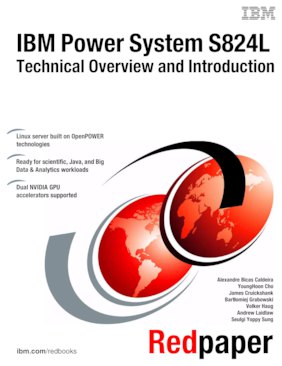About cookies on this site Our websites require some cookies to function properly (required). In addition, other cookies may be used with your consent to analyze site usage, improve the user experience and for advertising. For more information, please review your options. By visiting our website, you agree to our processing of information as described in IBM’sprivacy statement. To provide a smooth navigation, your cookie preferences will be shared across the IBM web domains listed here.

Published on 16 December 2014, updated 10 July 2017
Read in Google Books
Share this page:
ISBN-10: 0738454028
ISBN-13: 9780738454023
IBM Form #: REDP-5139-00
Authors: Scott Vetter, Alexandre Bicas Caldeira, YoungHoon Cho, James Cruickshank and Bartłomiej Grabowski
Abstract
This IBM® Redpaper™ publication is a comprehensive guide that covers the IBM Power System S824L (8247-42L) server that supports the Linux operating systems. The objective of this paper is to introduce the major innovative Power S824L offerings and their relevant functions:
- The new IBM POWER8™ processor, which is available at frequencies of 3.02 GHz and 3.42 GHz
- A processor that is designed to accommodate high-wattage adapters, such as NVIDIA graphics processing units (GPUs), that provide acceleration for scientific, engineering, Java, big data analytics, and other technical computing workloads
- Based on OpenPOWER technologies
- Two integrated memory controllers with improved latency and bandwidth
- Improved reliability, serviceability, and availability (RAS) functions
- IBM EnergyScale™ technology that provides features, such as power trending, power-saving, power capping, and thermal measurement
This publication is for professionals who want to acquire a better understanding of IBM Power Systems™ products.
This paper expands the current set of IBM Power Systems documentation by providing a desktop reference that offers a detailed technical description of the Power S824L server.
This paper does not replace the latest marketing materials and configuration tools. It is intended as an additional source of information that, together with existing sources, can be used to enhance your knowledge of IBM server solutions.
Table of Contents
Chapter 1. General description
Chapter 2. Architecture and technical overview
Chapter 3. Reliability, availability, and serviceability